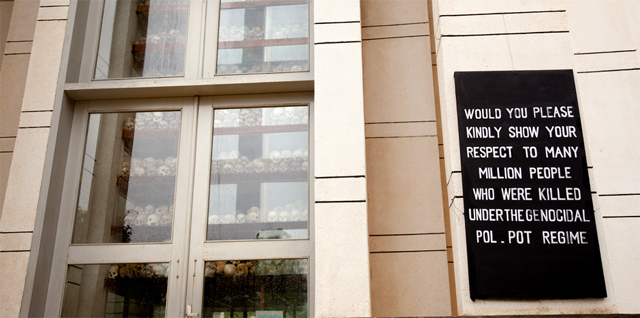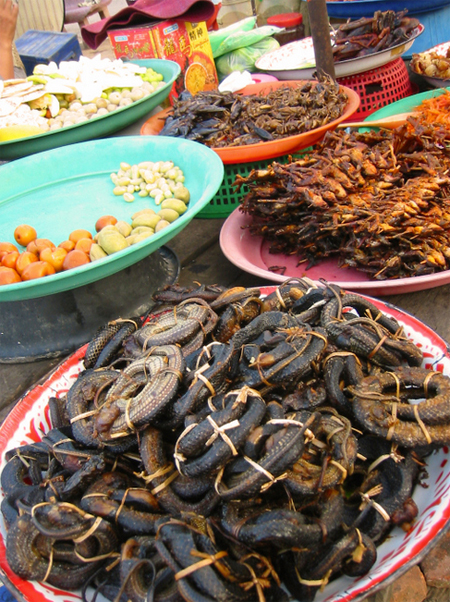
From the years 1975 to 1979, Pol Pot’s Khmer Rouge ruled Cambodia.
But despite the Maoist revolutionary’s belief that the ideal citizens
were the peaceful country peasants, his regime led to an estimated 1.7 million deaths in a country whose population stood at 8 million.
‘Like a nightmare’
If Hitler believed that Germans belonged to a supreme race he called “Aryans,” Pol Pot insisted that Cambodians were the Aryans of Asia.
If Hitler believed that Germans belonged to a supreme race he called “Aryans,” Pol Pot insisted that Cambodians were the Aryans of Asia.
In the eyes of the Khmer Rouge, urban spaces were symbols of
capitalism—the enemy, so to speak, of Pol Pot’s envisioned agricultural
economy, free from foreign influence. The capital city of Phnom Penh,
among others, was forcibly evacuated, its population thrust into hard
labor:
“Millions of
Cambodian city dwellers were now forced into manual slave work in rural
areas. Since they were only fed a tin of rice (180 grams) every two
days, they quickly began to die from disease, being overworked and
undernourished. This is how the "killing fields" came to be known.” (Mount Holyoke College)
 For
the ‘I-Witness’ documentary “A-Ping (Black Spider),” host Jay
Taruc journeyed to Cambodia to discover the how remnants of a dark past
can be seen in present-day life. He spoke with survivor Talep Rafat,
whose father was arrested by the Khmer Rouge and detained in a province
away from the rest of the family.
For
the ‘I-Witness’ documentary “A-Ping (Black Spider),” host Jay
Taruc journeyed to Cambodia to discover the how remnants of a dark past
can be seen in present-day life. He spoke with survivor Talep Rafat,
whose father was arrested by the Khmer Rouge and detained in a province
away from the rest of the family.
“Life was
horrible. It was like hell in this world, it was really hell,” Rafat
told Taruc. Three decades after Pol Pot’s rule ended, Rafat’s voice
shakes when talking about the past. “I don’t know how to describe it.
It’s like a nightmare.”
One of the harshest
prisons at the time was Security Prison 21, known to locals as S-21. It
was here that thousands were detained, tortured and executed—victims
included not just political opponents of the Khmer Rouge, but their
entire families.
Today, S-21 has become the Tuol
Sleng Genocide Museum. The buildings have largely been preserved, as
they were when the Khmer Rouge fell in 1979; there are now entire rooms
displaying photos of S-21’s prisoners.
The Tuol
Sleng Genocide Museum serves as an important, if grisly, marker
of Cambodia’s past—a reminder for future generations of what must never
happen again. But for survivors like Rafat, the images from those years
are ones he would rather forget.
“I don’t want
to remember it anymore. It’s very painful. Whenever I talk about this, I
get so emotional because it was so hard— I was separated from my family
and I had to stay home alone,” Rafat told Taruc, breaking down inside
Tuol Sleng. “I don’t want to see these things anymore. It’s enough.”
‘Anything to survive’
Under Pol Pot, millions suffered from malnutrition. Despite toiling in
the fields, ordinary Cambodians like Rafat had no access to the crops
they grew—the harvest went to the Khmer Rouge, which rationed out meager
portions to the populace.
Rafat recalls how
they ate nothing but gruel everyday: “At 11 o’clock, they would ring the
bell for us to get food. Everyone had to eat the same food…no meat,
no fish,” he says. “Until now, if you make porridge for my father, he
will say ‘enough.’ He doesn’t want to talk about it.”
 To
survive the ordeal, Cambodians took to eating whatever insects, frogs
and snakes, snails—whatever they could find. “Anything to survive,”
Rafat said.
To
survive the ordeal, Cambodians took to eating whatever insects, frogs
and snakes, snails—whatever they could find. “Anything to survive,”
Rafat said.
This included what they called a-ping,
or black spiders. About the size of an adult’s palm, this species of
tarantula is still eaten today, almost 25 years after Pol Pot’s harsh
regime. Today, a-ping is a high-protein street food eaten by curious tourists and knowing locals alike.
The market town of Skuon has earned the moniker ‘Spiderville’ because of the popularity a-ping
enjoys there. Despite the dark story behind how a-ping became part of
Cambodia’s cuisine, the people of Skuon have embraced exotic food
as part of their identity. Eating a-ping is no longer a necessity in desperate times, but a choice.
“People like to eat it fried,” a Skuon vendor told 'I-Witness.' “And
[tourists] want to hold the spiders and take pictures.” The small woman
laughed as she handed one to Jay Taruc, teasing him: “You’re Spiderman!”
The good with the bad
“Napatunayan ng aming paglilibot sa Cambodia na nananatili pa rin
ang kaugnayan ng nakaraan sa kasalukuyan sa pamamagitan ng kanilang
pagkain,” said Taruc. “Kadikit man ng mga pagkaing ito ang mapait at
malagim na karanasan, ito rin ang naging daan para sila ay mabuhay.”
It seems that the people of Cambodia take the good with the bad.
While Cambodia’s exotic cuisine is a reminder of their dark past, it is
also a reminder of their resilience—their strength in the face of
seemingly insurmountable struggles. — PF, GMA News

No comments:
Post a Comment